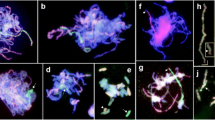Abstract
Homoeologous pairing at metaphase-I was analyzed in wild-type, ph2b, and ph1b hybrids of wheat and a low-pairing type of T. longissimum in order to study the effect of ph mutations on the pairing of T. longissimum chromosomes with wheat chromosomes. Chromosomes of both species, and their arms, were identified by C-banding. The three types of hybrids, with low-, intermediate-, and high-pairing levels, respectively, exhibited a very similar pairing pattern which was characterized by the existence of two types, A-D and B-S1, of preferential pairing. These results confirm that the S1 genome of T. longissimum is closely related to the B genome of wheat. The possible use of ph1b and ph2b mutations in the transfer to wheat of genes from related species is discussed.
Similar content being viewed by others
References
Alonso LC, Kimber G (1983) A study of genome relationships in wheat based on telocentric chromosome pairing. II. Z Pflanzenzuecht 90:273–284
Ceoloni C, Straus I, Feldman M (1986) Effect of different doses of group-2 chromosomes on homoeologous pairing in intergeneric hybrids. Can J Genet Cytol 28:240–246
Feldman M (1978) New evidence on the origin of the B genome of wheat. In: Ramanujan S (ed) Proc 5th Int Wheat Genet Symp vol. 1. Kapoor Art Press, New Delhi, pp 120–132
Fernández-Calvín B, Orellana J (1991) Metaphase-I bound-arm frequency and genome anlysis in wheat-Aegilops hybrids. I. Ae. variabilis-wheat and Ae. kotschyi-wheat hybrids with low- and high-homoeologous pairing. Theor Appl Genet 83:264–272
Fernández-Calvín B, Orellana J (1992) Relationships between pairing frequencies and genome affinity estimations in Aegilops ovataxTriticum aestivum hybrid plants. Heredity 68:165–172
Fernández-Calvín B, Orellana J (1993) Metaphase-I bound-arm frequency and genome analysis in wheat-Aegilops hybrids. 2. Cytogenetical evidence for excluding Ae. sharonensis as the donor of the B genome of polyploid wheats. Theor Appl Genet 85:587–592
Fernández-Calvín B, Orellana J (1994) Metaphase-I bound-arm frequency and genome anlysis in wheat-Aegilops hybrids. 3. Similar relationships between the B genome of wheat and the S or S1 genomes of Ae. speltoides, Ae. longissima and Ae. sharonensis. Theor Appl Genet 88:1043–1049
Friebe B, Tuleen N, Jian J, Gill BS (1993) Standard karyotype of Triticum longissimum and its cytogenetic relationship with T. aestivum. Genome 36:731–742
Giráldez R, Cermeño MC, Orellana J (1979) Comparison of C-banding pattern in the chromosomes of inbred lines and open-pollinated varieties of rye Secale cereale L. Z Pflanzenzuecht 83:40–48
Hutchinson J, Miller TE, Reader SM (1983) C-banding at meiosis as a means of assessing chromosome affinities in the Triticeae. Can J Genet Cytol 25:319–323
Islam AKMR, Shepherd KW (1991) Alien genetic variation in wheat improvement. In: Gupta PK, Tsuchiya T (eds) Chromosome engineering in plants: genetics, breeding, evolution. Elsevier, Amsterdam, pp 291–312
Islam AKMR, Shepherd KW (1992) Production of wheat-barley recombinant chromosomes through induced homoeologus pairing. 1. Isolation of recombinants involving barley arms 3HL and 6HL. Theor Appl Genet 83:489–494
Jaujar PP, Riera-Lizarazu O, Dewey WG, Gill BS, Crane CF, Benett JH (1991) Chromosome pairing relationships among the A, B, and D genomes of bread wheat. Theor Appl Genet 82:441–449
Kerby K, Kuspira J (1987) The phytogeny of the polyploid wheats Triticum aestivum (bread wheat) and Triticum turgidum (macaroni wheat). Genome 29:722–737
Kimber G (1983) Genome analysis in the genus Triticum. In: Sakamoto S (ed) Proc 6th Int Wheat Genet Symp, Kyoto University, Kyoto, pp 23–28
Kimber G, Alonso LC (1981) The analysis of meiosis in hybrids. III. Tetraploid hybrids. Can J Genet Cytol 23:235–254
Mello-Sampayo T (1971) Genetic regulation of meiotic chromosome pairing by chromosome 3D of Triticum aestivum. Nature New Biol 230:22–23
Naranjo T (1990) Chromosome structure of durum wheat. Theor Appl Genet 79:397–400
Naranjo T (1992) The use of homoeologous pairing in the identification of homoeologous relationships in the Triticeae. Hereditas 116:219–223
Naranjo T (1994) The homoeologous relationships of the arms of wheat chromosomes 2A and 2D to chromosome 2B and their effect on homoeolgous pairing. Chromosome Research 2:275–279
Naranjo T (1995) Chromosome structure of Triticum longissimum relative to wheat. Theor Appl Genet 91:105–109
Naranjo T, Fernández-Rueda P (1991) Homoeology of rye chromosome arms to wheat. Theor Appl Genet 82:577–586
Naranjo T, Roca A, Goicoechea PG, Giráldez R (1987) Arm homoeology of wheat and rye chromosomes. Genome 29:873–882
Naranjo T, Roca A, Goicoechea PG, Giráldez R (1988a) Chromosome structure of common wheat: genome reassignment of chromosomes 4A and 4B. In: Miller TE, Koebner RMD (eds) Proc 7th Int Wheat Genet Symp, Bath Press, Bath, UK, pp 115–120
Naranjo T, Roca A, Goicoechea PG, Giráldez R (1988b) Chromosome pairing in hybrids of ph1b mutant wheat with rye. Genome 30:639–646
Riley R, Chapman V (1958) Genetic control of the cytologically diploid behaviour of hexaploid wheat. Nature 182:713–715
Rogowsky PM, Guidet FLY, Langridge P, Shepherd KW, Koebner RMD (1991) Isolation and characterization of wheat-rye recombinants involving chromosome arm 1DS of wheat. Theor Appl Genet 82:537–544
Sears ER (1977) An induced mutant with homoeologus pairing in wheat. Can J Genet Cytol 19:585–593
Sears ER (1982) A wheat mutation conditioning an intermediate level of homoeologous chromosome pairing. Can J Genet Cytol 24:715–719
Sears ER (1984) Mutations in wheat that raise the level of meiotic chromosome pairing. In: Gustafson JP (ed) Proc 16th Stadler Genet Symp, Columbia, Mo. Plenum Press, New York, pp 295–300
Sears ER, Okamoto M (1958) Intergenomic chromosome relationships in hexaploid wheat. Proc 10th Int Congr Genet 2:258–259
Upadhya MD, Swaminathan MS (1967) Mechanisms regulating chromosome pairing in Triticum. Biol Zentrabbl 86 (suppl):239–255
Wall AM, Riley R, Chapman V (1971a) Wheat mutants permitting homoeologous chromosome pairing. Genet Res 18:311–328
Wall AM, Riley R, Gale MD (1971b) The position of a locus on chromosome 5B of Triticum aestivum affecting homoeologous pairing. Genet Res 18:329–339
Author information
Authors and Affiliations
Additional information
Communicated by G. E. Hart
Rights and permissions
About this article
Cite this article
Naranjo, T., Maestra, B. The effect of ph mutations on homoeolgous pairing in hybrids of wheat with Triticum longissimum . Theoret. Appl. Genetics 91, 1265–1270 (1995). https://doi.org/10.1007/BF00220939
Received:
Accepted:
Issue Date:
DOI: https://doi.org/10.1007/BF00220939




